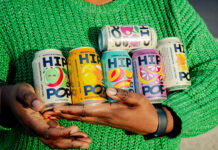
Robert Brooks, food & beverage Industry marketing manager at Omron, examines how automation in the food and beverage production supply chain delivers increased visibility and traceability.
High profile product recalls, greater emphasis on food safety and increasing consumer demand are driving improved product marking within the food and beverage industry.
There is a general demand by consumers to be better informed on the food and drink we consume. This is reflected not just in sell-by and use-by dates, but information on allergens, nutritional value, producer details and country of origin, to name a few.
It all contributes towards providing the right information to allow consumers make more informed choices.
To help meet the requirements of all stakeholders within the supply chain – from farm to fork – there has been a steady move towards standardisation in the way information on food and drink packaging is presented, supplemented by legislation to ensure absolute traceability through the supply chain. With many associations and pressure groups having influence in the food industry, track and trace requirements will only become more stringent.
The European Food Information to Consumers Regulation No 1169/2011 (FIC) brings together EU rules on general food labelling and nutrition labelling into one piece of legislation. The majority of the requirements of the new legislation applied to pre-packed foods from December 2014, and mandatory nutrition declarations for most pre-packed foods will come into force on 13 December 2016.
New rules on country of origin information for meat from sheep, pigs, goats and poultry have applied from April 2015. Topics covered by these regulations include dates of freezing of meat, compositional standards for minced meat, water content, caffeine content and even font sizes for labelling.
Surprisingly, once a product leaves the producer, there are no prescribed standards, either in terms of information you need to share or how you share it. Here, the onus is on an individual company (such as a contract packer) to have the necessary information to share with the relevant bodies if something goes wrong.
Manufacturers will look to automation for cost effective, flexible and secure solutions to traceability issues. GS1 is a neutral, not-for-profit, international organisation that develops and maintains standards for supply and demand chains across multiple sectors, including food and beverage and healthcare. GS1 has over a million member companies across the world.
GS1 standards provide a much wider framework for supply chain visibility. They are steadily being adopted within the food and beverage industry, providing a globally recognised framework for supply chain visibility and product traceability. GS1 provides standards for identifying items, locations, shipments, assets and associated information, as well as enabling data to be shared between the different parties in the supply chain.
These and other standards impose a requirement to print human and/or machine-readable codes on the product’s packaging, including alphanumeric codes, as well as 1D and 2D codes.
There are important differences between these printed codes, in terms of what information they can convey, what standards they meet, and where the data is intended to be used – from factory internal processes all the way to the retailer and the consumer.
ADDRESSING INLINE DETECTION
Integrating process controllers and vision equipment directly into the real-time network automates inspection tasks currently being carried out by human operators.
Modern production processes cannot rely on manual product inspection, and so the alphanumeric code should be machine readable, enabling automated inspection systems to check that the mark is present, is readable and is correct.
Automated systems can also manage shape recognition, in-factory quality measurements prior to packaging, and check that the right pack and the right label are married with the product itself, all set up in one system accessible via one interface. Adding further inspection tasks is significantly simplified.
Modules within automated machines can set themselves up rapidly and automatically (self-configuring), including the necessary automatic hardware definition, consistency checks and automatic initialisation. In this way, they have the flexibility required to adapt inspection to different sizes, containers and marketing programmes and eliminates human error, and so offer further benefits as demands increase for shorter, high speed product runs.
TOTAL COST OF OWNERSHIP
Price pressure is a significant hurdle as well and has generated two different trends. While a part-cost reduction is a common approach, manufacturers are at risk of the consequences of errors, as a retailer will clear shelves and will charge and fine the perpetrator. This highlights the need to evaluate the overall task and measure the cost improvements, taking Total Cost of Ownership (TCO) into consideration.
TCO is a management accounting concept intended to help buyers and owners determine all the direct and indirect costs of a product or system. It goes beyond the initial manufacturing cycle time and cost to produce food or to make parts. It can, for example, include an estimate of the relative risk of alternative strategies, such as poor reliability, or the hidden costs of doing business overseas.
Automation systems are key to a TCO approach, as a successfully implemented system will add to reliability and product traceability as shown in this article.
Typically, to maximise the gain, an automation partner will want to get involved at the earliest feasibility stage. Every project is different, and in some cases a new system will interface with existing equipment and in others will operate independently. Most will then work through a specialist systems integrator or machine builder to build the project and deliver the improved levels of reliability and traceability that are increasingly expected in today’s food and beverage industry.












